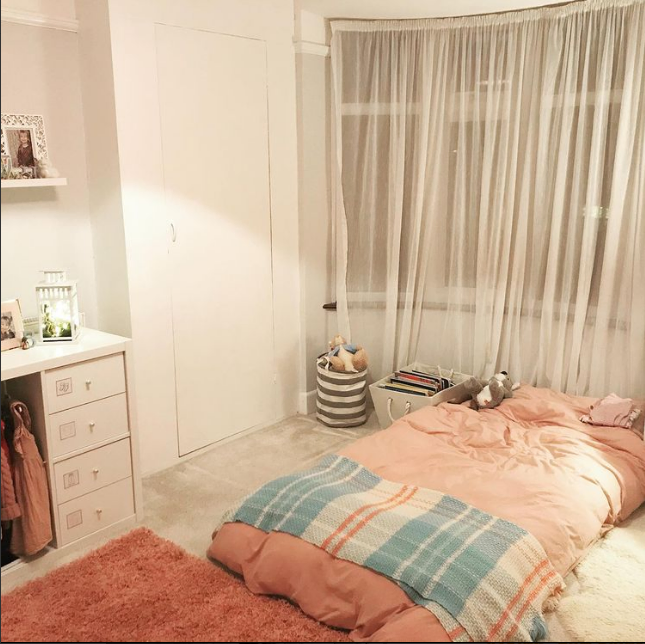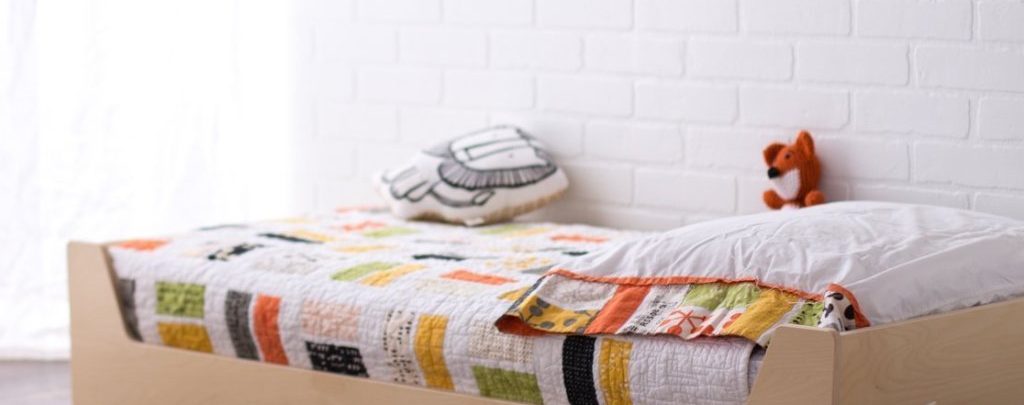Dr Maria Montessori believed that children thrive when given the freedom to move and learn independently. This is seen in the set up of Montessori classrooms, homes and play spaces and even extends to a child’s sleep space.
Believe it or not, encouraging independence, even in the youngest of babies, might seem like more trouble than it’s worth at the time (hello little one rolling out of bed) BUT these children quickly come into their own and thrive with this independence. Some young babies in floor beds will even crawl off and put themselves to bed (oh wouldn’t that be nice!)
So what is a floor bed?
Put simply, it’s a bed – on the floor! Yep, nothing complicated. Some parents choose to use a mattress directly on the floor, others will place it on a slatted base for ventilation, and you can also purchase wooden frames with slats underneath in which to put your mattress.
However, for parents starting out, I always suggest the simple mattress on the floor approach. It requires no financial investment for you, there’s nothing hard for little ones to bang their heads on etc. and it can usually be done with what you’ve already got at home (a single or cot mattress).
Why choose a floor bed?
Freedom of Movement
A floor bed will give your baby or child the ultimate freedom of movement. Without restrictions of cot bars, bed rails etc. your baby or child can:
- get into and out of bed easily, as soon as they are mobile.
- experiment with movement in this space – they can roll, crawl, jump etc. without the fear of injury.
- your baby doesn’t feel penned in or contained by a cot. When you actually think about the view from a cot, it’s like a little wooden jail for our babies.
- as a parent, it can actually make your life easier! If your baby/child is in a cot – what do they do when they wake? Probably cry or call out for you to come and get them out. In a safely set up room with a floor bed, your baby doesn’t need your input. They can easily get out of bed themselves, make their way to a small toy shelf or book box and easily entertain themselves for a period of time (hello longer lie ins!).
Respectful Parenting
Montessori and RIE parenting have many aspects in common – the main one being that we are giving our children the space, trust and respect to do as much for themselves as they possibly can. Dr Maria Montessori said, “Help me, to help myself” and this is such an important philosophy for parenting, as well as sleep.
By giving our child a bed they can freely access themselves, as well as small toy shelves at a low height with a few simple materials, and some age appropriate books, we are telling our child that we not only trust them and their independence but we encourage it.
We are giving them the freedom to move into and out of their sleep space as they feel necessary – and many babies who are used to sleeping in a floor bed will still choose to take themselves back to their bed when they’re tired. We’re creating a safe, happy space for them – where they can take control of their body and have the freedom to take themselves to bed when they need to, rather than a confined space where they are ‘put’ and left at times dictated by us.
Perfect for breastfeeding parents
With a floor bed, it takes a whole lot of the difficulty out of doing night feeds. There’s no lifting in and out of the cot, no disturbing your baby who has fallen asleep feeding but now needs to be lowered back into the cot. You can lie on your floor bed next to your baby, feed them to sleep and then simple unlatch and roll away.
Some parents who are transitioning away from co-sleeping will even place a larger single mattress next to their child’s floor bed so they can sleep nearby and slowly retreat as their child is able to sleep more independently. This is also a space saver in small nurseries, as there’s no need for a bulky cot or a nursing chair.
But won’t they just fall out?
Yep, probably! For any baby or child who is first moved to a floor bed, they probably will fall out a few times. Is this a problem? Not really! Just like anything, they need to learn these boundaries and have the experience of falling out to development the spacial awareness to stop themselves doing it. We don’t go to bed every night as adults, worrying that we’ll fall out of our bed. This is because we’ve spent time sleeping in a bed without railings, and we have developed the spacial awareness to avoid the edge.
The sooner we give our babies/children this experience, the sooner they will develop that too. The other important point to make here is that if your child falls out in the night, and stays asleep on the floor – it’s not a problem. When setting up a room for a floor bed (more on that later), we make sure the space around the bed is clear and safe, just in case this does happen. If they’re fast asleep and comfortable – oh well!
Who might a floor bed be suitable for?
There are very few situations where I would discourage parents from using a floor bed. Here are some examples of situations where you might like to consider a floor bed:
- from birth, instead of using a cot at all
- with an older child, rather than transition to a toddler bed or straight to a high single bed
- transitioning a child who has previously been bed sharing with a parent
- with a child who is currently being rocked/fed to sleep, and waking when placed in their cot
- for families trying to transition away from rocking/feeding to sleep in a gentle way
- older siblings, who like to sleep together, may benefit from a larger double mattress set up as a floor bed
What does a floor bed look like?
Here are some examples of different set ups with a floor bed:
Floor bed with bed frame, for baby:

Floor bed, mattress on floor for baby:


How to set up a floor bed safely:
Under 12 month old
- Secure furniture to the wall.
- Keep as much furniture as possible low to the ground. Consider a small 4×1 IKEA Kallax unit as a great toy storage space.
- Keep play materials in the room simple! Just a couple of simple toys for them to place with is plenty. Think about large toys which won’t be a choking hazard and which you’d be happy for your baby to play with independently. Chunky blocks, wooden animals or a Montessori spinning drum are a good place to start. A small basket of board books is also a good edition.
- Keep the space around the floor bed clear. If baby should roll out of bed, they should simply roll on to a flat surface. If you have hard floors you might like to add a rug under the edge of the bed to provide a softer landing. Try to choose a low pile (like carpet).
- Make sure electrical sockets are covered. Plug insert covers are no longer recommended for safety reasons, but these socket covers are a great option which allow you to still use powerpoints without little fingers being able to access them. Alternatively you could place furniture in front of sockets.
- Avoid things like feeding chairs etc. which your little one could climb on.
- Make sure curtains are out of reach, same goes for the cords of curtains or blinds.
- Your baby’s bed should be a firm mattress, with fitted sheet and without loose duvets/blankets/pillows.
- Babies under 12 months are safest sleeping in an age appropriate sleep sack rather than having loose blankets etc.
12 months +
- Secure furniture to the walls and choose low furniture for toy storage etc. as above.
- Make sure electrical sockets are covered. Plug insert covers are no longer recommended for safety reasons, but these socket covers are a great option which allow you to still use powerpoints without little fingers being able to access them. Alternatively you could place furniture in front of sockets.
- Keep the space around the floor bed clear. If your child should roll out of bed, they should simply roll on to a flat surface. If you have hard floors you might like to add a rug under the edge of the bed to provide a softer landing. Try to choose a low pile (like carpet).
- If you have units with draws in the room, make sure they cannot be opened by your child as these provide a surface for little ones to attempt climbing on.
- Keep your child in an age appropriate sleep sack for as long as they’re happy doing this. At 2 years+, many parents will choose to transition to a pillow and duvet/blanket.
- Avoid things like feeding chairs etc. which your little one could climb on.
- Make sure curtains are out of reach, same goes for the cords of curtains or blinds.
- Once again think about keeping toys/materials in the room simple. Just a couple of chunky toys for your child to play with and avoid any choking hazards.

General advice
When decorating your baby’s room – think about adding decoration/images/pictures down at their level. Hanging pictures/shelves at adult eye height looks nice to us but our babies can’t enjoy them! Using some simple wall decals down at baby’s height provides something stimulating for them to look at, or you might consider hanging a simple mobile like the Montessori Dodecahedron mobiles above, at a height where your baby/child can see, but not reach, them.
Floor beds are a fantastic solution to many sleep difficulties, and also make a great option for families without sleep issues, who just want to embrace respectful parenting principles and create a free, independent sleep space for their child.




Leave a Comment
You must be logged in to post a comment.